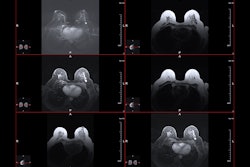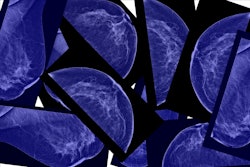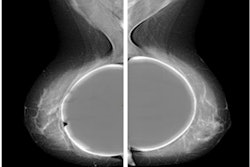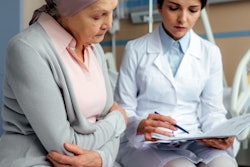
Discrepancies between professional guidelines and the expectations and needs of society are adding fuel to the debate over MRI's role in breast cancer screening. Yet the evidence for functional screening is gaining ground for certain risk groups, according to speakers at a high-level European panel discussion.
The American College of Radiology recently followed the European Society of Radiology's (ESR's) recommendations for managing women at higher-than-average risk of developing breast cancer including those with extremely dense breasts: ACR recommended that women should be informed about breast density and be offered supplemental screening, most logically MRI.
The guidance from both societies goes way further than updated guidance in March from the European Commission Initiative on Breast Cancer (ECIBC), which fails to endorse MRI for women with very dense breasts.
While recommending that women 45 to 49 years old undergo screening every two to three years (down from the age of 50, previously), the ECIBC recommends digital breast tomosynthesis (DBT) for women with high mammographic breast density detected previously, but not for women found to have high mammographic density for the first time. It also recommends not implementing tailored MRI or automated breast ultrasound (ABUS) for women with highly dense breast tissue.
So what does this mean for European radiologists and women? Where is the science heading, and what impact is AI having? These topics were addressed during the breast session at the the European Society of Radiology's connAction online meeting held on 2 June.
The ECIBC's guidance was based on evidence that did not include the recent Dutch study, DENSE, and other interim evidence, noted Dr. Ritse Mann, chair of the European Society of Breast Imaging (EUSOBI) and breast lead and interventional radiologist at Radboud University Nijmegen, the Netherlands.
There is now strong evidence for functional techniques such as MRI reducing cancer mortality, without any dramatic increase in false positives, he said.
 AI may make future mammography screening adequate for women with dense breasts, noted Dr. Ritse Mann at connAction.
AI may make future mammography screening adequate for women with dense breasts, noted Dr. Ritse Mann at connAction.Providing the radiologist's perspective on the updated EU recommendations and their impact on clinical practice, Mann noted that it was time to seriously invest in implementing functional screening.
He pointed to how mammography screening leads to mortality reduction of around 20% in the screenable population and of 40% among women who actually attend screening.
"The idea behind screening is quite simple: we try to find cancers that are a bit smaller than when they appear clinically .... and prevent metastatic spread. If we find cancers earlier, that gain in survival gets better," he stated.
He flagged how current breast screening in the Netherlands shows that cancer that is T1N0 (less than 2 cm and not spread to the nodes) does not kill.
"With that in mind, if we can achieve this, we can basically solve breast cancer mortality in the screened population. But screening reality is a bit different. In the Dutch population roughly 25% of cancers are over T2 and around 35% are lymph node positive at the time of detection which means that despite all our efforts and the impressive 40% in cancer mortality reduction, we still fail too often," he told participants at the event.
Functional techniques
He highlighted how other screening modalities may transition breast cancer stage to that T1N0 level.
Those that are most effective use contrast -- including contrast-enhanced mammography, ultrasound, breast MRI, and abbreviated MRI. After a negative mammogram, these tools find somewhere between 10 and 25 additional cancers per 1,000 women screened. Considering that normal screening yield is around 6 cancers per 1,000 women screened these numbers are enormous, he noted.
Studies in different cohorts have shown that with breast MRI after a negative mammogram, 15 to 20 additional cancers can be found per 1000 women screened. American Cancer Society guidelines state that breast MRI should be offered to BRCA mutation carriers and other high-risk women such as those with a first-degree relation to BRCA carriers, even if they themselves are untested, and to women with a lifetime risk of over 20 to 25%.
In this population with a 20% to 50% lifetime risk based upon family history, MR finds more cancers and smaller (12 mm in size vs. 18 mm), a lower stage in general -- very few T2 and T3 cancers -- and much more often lymph node negative, noted Mann.
In the next category of intermediate risk (15% to 20% lifetime risk) for example in women with lobular carcinoma in situ or women with extremely dense breasts, opinion on MRI changed with DENSE, a study that randomized women to MRI or to usual care after a negative mammogram.
The study showed that offering MRI to these women reduced the interval cancer rate from 5 cancers per 1,000 women screened to 0.8 per 1,000, an 85% reduction. In the second round of DENSE, incidence of cancers found was lower (5.8 vs. 16.5/1,000 screenings), with a sharp reduction in false positives (26.3 vs. 79.8) indicating cancers were found earlier preventing metastatic spread.
"In this second round, all cancers detected were node-negative and early stage, transitioning breast cancer into a curable disease for these kinds of women," Mann said.
Affordable MRI?
MRI screening is affordable, costing around 75,000 euros per life saved, or 11,500 euros per Quality Adjusted Life Year (QALY), according to Mann.
"Considering we're willing to spend 80,000 euros per QALY in the therapeutic setting, it's relatively cheap but the obvious issue is we need to be able to offer sufficient MRIs and that is the challenge," Mann said. "Abbreviated MR makes cost-effectiveness even more interesting and a better option than shifting towards tomosynthesis," he added.
During the panel discussion, fellow panelist Dr. Caroline Drukker, surgical oncologist from the Netherlands Cancer Institute, Amsterdam, also pointed to the need for a detailed plan about who is eligible for MRI and who is not.
"The term 'Where medically appropriate' is still open to interpretation in the new guidelines and therefore more detail is needed," she said. "In the Netherlands screening participation is 75% which shows that women want to be screened. As medical professionals our job is to inform them properly and offer them the right way of screening. And that might be more screening for some and less screening for others."
The panel discussion threw up several questions on how to implement a contrast-based screening modality in women of higher risk.
"This requires investment. This isn't about funding another study but investing millions to implement [contrast-based screening], but these millions will pay off at the other end in QALY," noted Mann. "The other issue is not burdening our technicians with extra screening but adjusting screening frequencies so that they have breathing space. It's essential to make this viable. And for radiologists, AI implementation in the evaluation of screening tests will be vital," he responded.
He pointed to how AI algorithms that can help find cancers on mammography and predict women's risk of developing cancer may make mammography screening adequate for women with dense breasts in the near future.
Alternative modalities
But what about DBT? Is Europe likely to see tomosynthesis become gold standard as in the U.S.?
"DBT is better than mammogram but there is so much more to read and there we're getting into workload issues again. So we'll need AI to help interpret all these screens. As soon as AI can work as a standalone reader, DBT will be implemented everywhere. At the moment what is holding us back is how to read 300 DBTs in a morning when interpretation takes double the time of mammogram reading," Mann said.
Alternatively, contrast-enhanced mammography could be as good as MRI, and most likely outperforms ultrasound but more data on how it fares for screening is needed, for example in its capacity to detect lesions under 1 cm.
Closing the session, moderator Prof. Michael Fuchsjäger, chair of radiology at the Medical University of Graz, Austria, presented the new ESR guidance, which recommends tailored screening programs for women of higher-than-average risk and for women with extremely dense breasts.
"Early risk stratification, using genetic variants, mutations, and AI assessment will drive screening of the future. Tailored screening will evolve into personalized screening based on functional imaging and women's preferences," he told participants. "Research will focus on novel functional and blood-based techniques, as well as AI risk stratification and interpretation."
You can watch the 60-minute session, "Breast cancer screening: the updated EU council recommendations and its impact on clinical practice," on demand on the ESR website.



















